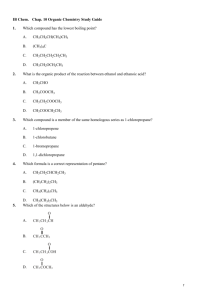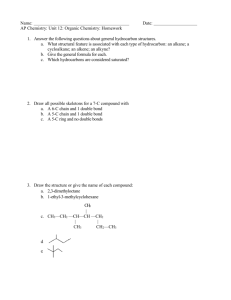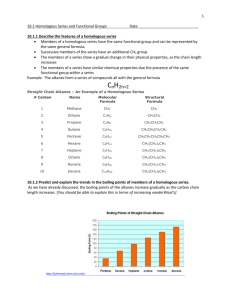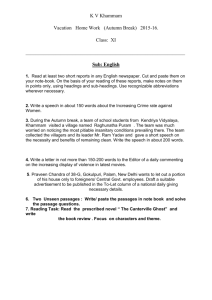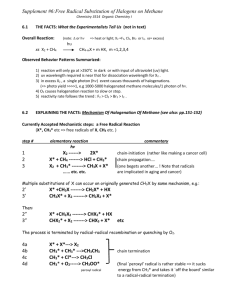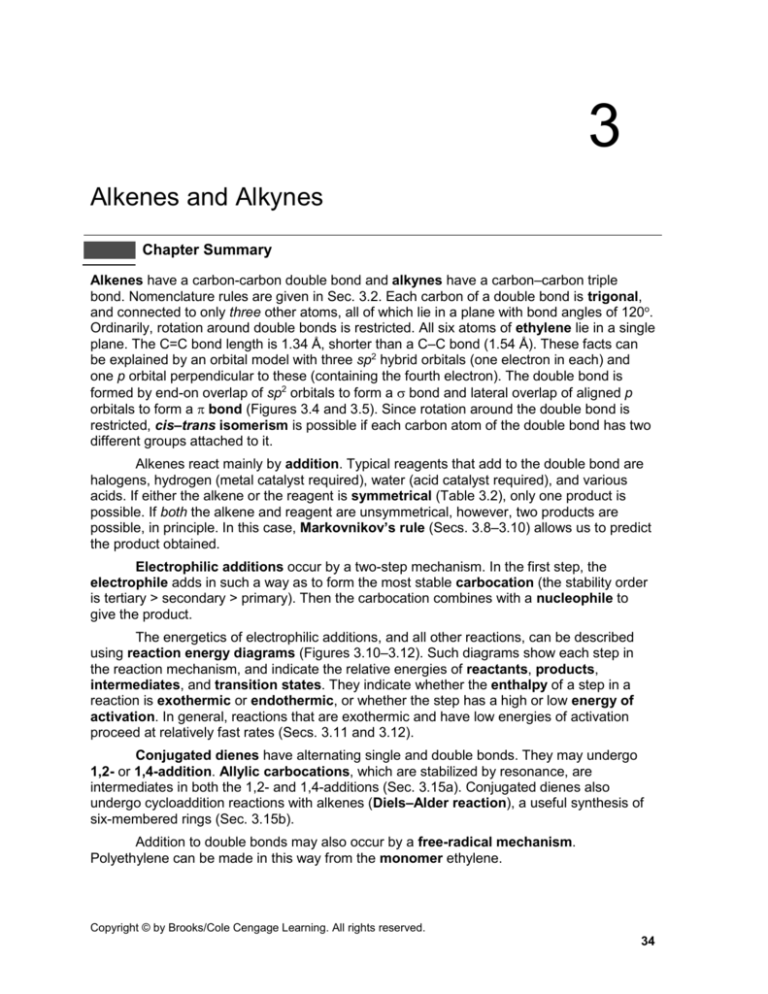
3
Alkenes and Alkynes
Chapter Summary
Alkenes have a carbon-carbon double bond and alkynes have a carbon–carbon triple
bond. Nomenclature rules are given in Sec. 3.2. Each carbon of a double bond is trigonal,
and connected to only three other atoms, all of which lie in a plane with bond angles of 120o.
Ordinarily, rotation around double bonds is restricted. All six atoms of ethylene lie in a single
plane. The C=C bond length is 1.34 Å, shorter than a C–C bond (1.54 Å). These facts can
be explained by an orbital model with three sp2 hybrid orbitals (one electron in each) and
one p orbital perpendicular to these (containing the fourth electron). The double bond is
formed by end-on overlap of sp2 orbitals to form a bond and lateral overlap of aligned p
orbitals to form a bond (Figures 3.4 and 3.5). Since rotation around the double bond is
restricted, cis–trans isomerism is possible if each carbon atom of the double bond has two
different groups attached to it.
Alkenes react mainly by addition. Typical reagents that add to the double bond are
halogens, hydrogen (metal catalyst required), water (acid catalyst required), and various
acids. If either the alkene or the reagent is symmetrical (Table 3.2), only one product is
possible. If both the alkene and reagent are unsymmetrical, however, two products are
possible, in principle. In this case, Markovnikov’s rule (Secs. 3.8–3.10) allows us to predict
the product obtained.
Electrophilic additions occur by a two-step mechanism. In the first step, the
electrophile adds in such a way as to form the most stable carbocation (the stability order
is tertiary > secondary > primary). Then the carbocation combines with a nucleophile to
give the product.
The energetics of electrophilic additions, and all other reactions, can be described
using reaction energy diagrams (Figures 3.10–3.12). Such diagrams show each step in
the reaction mechanism, and indicate the relative energies of reactants, products,
intermediates, and transition states. They indicate whether the enthalpy of a step in a
reaction is exothermic or endothermic, or whether the step has a high or low energy of
activation. In general, reactions that are exothermic and have low energies of activation
proceed at relatively fast rates (Secs. 3.11 and 3.12).
Conjugated dienes have alternating single and double bonds. They may undergo
1,2- or 1,4-addition. Allylic carbocations, which are stabilized by resonance, are
intermediates in both the 1,2- and 1,4-additions (Sec. 3.15a). Conjugated dienes also
undergo cycloaddition reactions with alkenes (Diels–Alder reaction), a useful synthesis of
six-membered rings (Sec. 3.15b).
Addition to double bonds may also occur by a free-radical mechanism.
Polyethylene can be made in this way from the monomer ethylene.
Copyright © by Brooks/Cole Cengage Learning. All rights reserved.
34
Alkenes and Alkynes
35
Alkenes undergo a number of other reactions, such as hydroboration,
permanganate oxidation, and ozonolysis.
Triple bonds are linear and the carbons are sp-hybridized (Figure 3.16). Alkynes,
like alkenes, undergo addition reactions. A hydrogen connected to a triply bonded carbon is
weakly acidic and can be removed by a very strong base such as sodium amide, NaNH2, to
give acetylides.
Reaction Summary
Additions to the Double Bond
C
C
C
+
C
C
+
C
(X = Cl or Br)
X2
Pd, Pt, or Ni
H2
+
H
H+
OH
C
C
X
X
C
C
H
H
C
C
H OH
(an alcohol)
C
C
+
H
X
(X = –F, –Cl,
–Br, –I, –OSO 3H,
–OCR
C
C
H
X
O
Conjugated Dienes
C
C
C
X2
C
C
C
C
C + C
X X
1,2-addition
C
C
C
H
C
X
C
X = Cl or Br
C
C
C
C + C
H X
1,2-addition
C
C
C
C
C
C
C
C
C
C
C
Polymerization of Ethylene
n H2C
CH2
catalyst
( CH2
Copyright © by Brooks/Cole Cengage Learning. All rights reserved.
C
C
H
X
1,4-addition
C
heat
C
X
X
1,4-addition
Cycloaddition (Diels–Alder)
C
C
CH2 ) n
36
Chapter 3
Hydroboration–Oxidation
3 R
BH3
CH CH2
H2 O2
HO –
(RCH2CH2 )3B
3 RCH2CH2 OH
Permanganate Oxidation
RCH CHR
KMnO4
RCH CHR +
MnO2
OH OH
Ozonolysis
C
O3
C
C
O
+
O
C
Additions to the Triple Bond
R
C
C
R' +
H2
Lindlar’s
R
catalyst
H
R'
C
C
H
R
R
C
C
H
+
X2
X
C
X
C
C
H
+
H
X
H
C
C
C
X
RCX2 CH3
H
O
H2 O, Hg2+, H+
H
H
C
X
R
RCX2 CHX2
H
R
R
X2
C
C
R
CH3
Alkyne Acidity
NH3
RC CH + NaNH2
RC C – Na+ +
NH3
Mechanism Summary
Electrophilic Addition (E+ = electrophile and Nu :– = nucleophile)
C
C
E+
C
Nu: –
C
+
E
carbocation
C
C
E
Nu
C
C
1,4-Addition
C
C
C
C
E+
C
+
C
C
C
C
+
C
Nu: – E
E
E
C
C
C
C
Nu
Copyright © by Brooks/Cole Cengage Learning. All rights reserved.
Alkenes and Alkynes
37
Free-Radical Polymerization of Ethylene
R
R
+
C
C
C
C
+
R
C
C
C
C
R
C
C
C
C
(and so on)
Learning Objectives
1.
Know the meaning of: saturated and unsaturated; alkene, alkyne, and diene;
conjugated, cumulated, and isolated double bonds; vinyl and allyl groups.
2.
Know the meaning of: trigonal carbon, sp2 hybridization, restricted rotation, and
bonds, cis and trans double-bond isomers.
3.
Know the meaning of: addition reaction, Markovnikov’s rule, electrophile,
nucleophile, symmetrical and unsymmetrical double bonds and reagents,
carbocation.
4.
Know the meaning of: equilibrium constants, reaction enthalpy, energy of activation,
transition state.
5.
Given information about the energetics of a reaction, be able to construct an
appropriate reaction energy diagram.
6.
Know the meaning of: 1,2-addition, 1,4-addition, cycloaddition, diene, dienophile,
polymer, monomer, polymerization.
7.
Know the meaning of: hydroboration, glycol, ozone, ozonolysis, combustion.
8.
Given the structure of an acyclic or cyclic alkene, alkyne, diene, and so on, state the
IUPAC name.
9.
Given the IUPAC name of an alkene, alkyne, diene, and so on, write the structural
formula.
10.
Given the molecular formula of a hydrocarbon and the number of double bonds,
triple bonds, or rings, draw the possible structures.
11.
Given the name or abbreviated structure of an unsaturated compound, tell whether it
can exist in cis and trans isomeric forms and, if so, how many. Draw them.
12.
Given an alkene, alkyne, or diene, and one of the following reagents, draw the
structure of the product reagents: acids such as HCl, HBr, Hl, and H2SO4; water in
the presence of an acid catalyst; halogens such as Br2 and Cl2; hydrogen and Pd, Pt
or Ni.
13.
Given the structure or name of a compound that can be prepared by an addition
reaction, deduce what unsaturated compound and what reagent react to form it.
14.
Write the steps in the mechanism of an electrophilic addition reaction.
15.
Given an unsymmetrical alkene and an unsymmetrical electrophilic reagent, give the
structure of the predominant product (that is, apply Markovnikov’s rule).
16.
Given a conjugated diene and a reagent that adds to it, write the structures of the
1,2-and 1,4-addition products.
Copyright © by Brooks/Cole Cengage Learning. All rights reserved.
38
Chapter 3
17.
Given a diene and dienophile, write the structure of the resulting cycloaddition
(Diels–Alder) adduct.
18.
Given the structure of a cyclic compound that can be synthesized by the Diels–Alder
reaction, deduce the structures of the required diene and dienophile.
19.
Given an alkyne, write the structures of products obtained by adding one or two
moles of a particular reagent to it.
20.
Write the steps in the mechanism of ethylene polymerization catalyzed by a free
radical.
21.
Write the structure of the alcohol produced from the hydroboration–oxidation
sequence when applied to a particular alkene.
22.
Given an alkene or cycloalkene (or diene, and so on), write the structures of the
expected ozonolysis products.
23.
Given the structures of ozonolysis products, deduce the structure of the unsaturated
hydrocarbon that produced them.
24.
Draw orbital pictures for a double bond and a triple bond.
25.
Draw conventional structures for the contributors to the resonance hybrid of an allyl
cation.
26.
Describe simple chemical tests that can distinguish an alkane from an alkene or
alkyne.
27.
Know the meaning of: cracking, alkylation, isomerization, platforming, and octane
number as applied to petroleum refining.
ANSWERS TO PROBLEMS
Problems Within the Chapter
3.1
The formula C4H6 corresponds to CnH2n-2. The possibilities are one triple bond, two
double bonds, one double bond and one ring, or two rings.
acyclic
cyclic
3.2
Compounds a and c have alternating single and double bonds, and are conjugated.
In b and d, the double bonds are isolated.
3.3
a.
1
2
3
H2C C CH3
Br
b.
1
2
CH3
C
CH3
C
3
CH3
4
CH3
2-bromopropene
2,3-dimethyl-2-butene
Copyright © by Brooks/Cole Cengage Learning. All rights reserved.
Alkenes and Alkynes
c.
39
1
2
d.
3
Cl CH CHCH3
CH3
2
1
1- iodoopropene
1-methylcyclohexene
e.
1
2
3
f.
4
H2C C CH CH2
1
HC
CH3
23
4
5
6
CCH2CH2CH2CH3
1-hexyne
2-methyl-1,3-butadiene (also
called isoprene)
3.4
a.
First write out the five-carbon chain, with a double bond between carbon-2
and carbon-3:
1
2
3
4
5
C C C C C
Add the substituents:
1
2
3
4
5
C
C
C
C
C
H3C
CH3
Fill in the hydrogens:
1
2
3
CH3
C
CH CH CH3
H3C
b.
CH3CH2
d.
H2C
CCH2CH3
4
5
or
(CH3 )2C
CHCH(CH3 )2
CH3
c.
Cl
Cl
C CH CH2
Cl
3.5
a.
b.
allyl group
CH2CH CH2
or
vinyl group
CH CH2
3.6
Compounds a and c have only one possible structure because in each case one of
the carbons of the double bond has two identical substituents:
Copyright © by Brooks/Cole Cengage Learning. All rights reserved.
40
Chapter 3
a.
H2C
b.
CH3CH2
CHCH3
CH2CH3
C
CH3CH2
C
H
C
H
(CH3 )2C
d.
CH3
H
CH2CH3
trans -3-hexene
CHCH3
CH2CH2CH3
C
C
H
cis -3-hexene
c.
H
and
CH3
C
H
and
C
H
C
H
cis -2-hexene
CH2CH2CH3
trans -2-hexene
3.7
The electron pair in a bond lies directly between the nuclei it joins. In a bond, the
electron pair is further from the two nuclei that it joins. Therefore more energy is
required to break a bond than a bond.
3.8
a.
One bromine atom adds to each doubly bonded carbon, and the double bond
in the starting material becomes a single bond in the product:
H2C
CHCH2CH3 + Br2
H2C
CHCH2CH3
Br Br
b.
Br
+ Br2
Br
3.9
a.
OH
+ H
OH
H
+
H
b.
CH3CH CHCH3 + H OH
H+
CH3CH2CHCH3
OH
3.10
a.
CH3CH CHCH3 + H
I
CH3CH2CHCH3
I
b.
+ H
3.11
a.
H2C
Br
Br
CHCH2CH3
This doubly bonded carbon has the most hydrogens.
H
Cl
Copyright © by Brooks/Cole Cengage Learning. All rights reserved.
Alkenes and Alkynes
41
This is the more electropositive part of the reagent.
+ –
CHCH2CH3 + H Cl
H2C
CH3 CHCH2CH3
Cl
b.
OH
+ –
CHCH3 + H OH
CH3 C
CH3 C
CH3
CH2CH3
CH3
3.12
Since both carbons of the double bond have the same number of attached
hydrogens (one), application of Markovnikov’s rule is ambiguous. Both products are
formed, and the reaction is not regiospecific.
3.13
a.
b.
c.
3.14
The order of stability is c > a > b.
3.15
eq. 3.15:
Secondary; there are two carbons bonded to the positively charged carbon.
Primary; one carbon is bonded to the positively charged carbon.
Tertiary; three carbons are bonded to the positively charged carbon.
+
CH3 C
CH2 + H +
CH3 C
CH3
CH3
CH3
H
+
CH3 C
CH3 + H
O
H
CH3 C
CH3
H
H
+O
CH3
H
H
+O
CH3 C
CH3
O
CH3
CH3 C
CH3
CH3 + H +
CH3
The intermediate carbocation is tertiary. If, in the first step, the proton had added to
the other carbon of the double bond, the carbocation produced would have been
primary:
H
CH3 C
CH2 + H +
CH3
Copyright © by Brooks/Cole Cengage Learning. All rights reserved.
CH3 C
+
CH3
CH3
42
Chapter 3
eq. 3.16:
CH3 + H +
CH3
+
CH3
+
CH3 +
I
–
I
The intermediate carbocation is tertiary. Had the proton added to the methyl-bearing
carbon, the intermediate carbocation would have been secondary:
CH3
CH3 + H
+
+
H
3.16
Ea
reactants
ENERGY
H
products
REACTION COORDINATE
Because we are told that the reaction is very exothermic, the diagram is drawn with
the energy of the reactants much higher than the energy of the products (large and
negative H). Because we are told that the reaction is very fast, the diagram is
drawn with a small energy of activation (Ea).
Copyright © by Brooks/Cole Cengage Learning. All rights reserved.
Alkenes and Alkynes
43
3.17
Ea
ENERGY
products
H
reactants
REACTION COORDINATE
Because we are told that the reaction is slightly endothermic, the diagram is drawn
with the energy of the reactants slightly lower than the energy of the products (small
and positive H). Because we are told that the reaction is very slow, the diagram is
drawn with a large energy of activation (Ea).
3.18
A reaction energy diagram that fits the requirements stated in the problem is shown
below. Notice that the diagram is a composite of the two diagrams drawn for
Problems 3.17 and 3.16, in that order.
transition state #1
transition state #2
E a#2
Ea #1
intermediate
H#1
ENERGY
reactants
H#2
H for overall reaction
products
REACTION COORDINATE
3.19
The boron adds to the less substituted carbon of the double bond, and, in the
oxidation, the boron is replaced by an OH group. Note that the acid-catalyzed
hydration of the same alkene would give the alcohol (CH3)2C(OH)CH2CH3 instead,
according to Markovnikov’s rule.
Copyright © by Brooks/Cole Cengage Learning. All rights reserved.
44
Chapter 3
H
CH3 C
1. BH3
CHCH3
CH3
3.20
CH3 C
2. H2O2, HO –
CHCH3
CH3
1. BH3
CH CH2
OH
CH2CH2OH
2. H2O2, NaOH
Acid-catalyzed hydration of vinylcyclohexane occurs in the Markovnikov sense:
OH
H2O, H+
CH CH2
CH
CH3
vinylcyclohexane
3.21
a.
H
CH3
C
catalyst
CH2 + H2
CH3 C
CH3
b.
CH3
CH3
CH3
H
CH3
+ H2
catalyst
H
CH3
CH3
3.22
1
CH2
CH CH CH2
CH2
CH CH CH2
+ H+
adds to
C-1
adds to
2
+ H+
C-2
1
+
CH3 CH CH CH2
allylic carbocation,
stabilized by resonance
2
+
CH2 CH2 CH CH2
primary carbocation, much
less stable than the allylic
carbocation
3.23
+
3.24
3.25
CH2
CH CH
+
CH2
Br 2
CH2
CH CH
Br
Br
1,2-addition
CH2
+
CH2
CH CH CH2
Br
Br
1,4-addition
To find the structures of the diene and dienophile, break the cyclohexene ring just
beyond the ring carbons that are connected to the double bond (the allylic carbons):
Copyright © by Brooks/Cole Cengage Learning. All rights reserved.
Alkenes and Alkynes
45
The equation is:
3.26
a.
heat
b.
O
CN
CN
CN
3.27
CH3CH CHCH3
+
KMnO4
CH3CH CHCH3
OH OH
+
MnO2
(brown precipitate)
3.28
3.29
a.
CH3C
CH
+
Br2
b.
CH3C
CH
+
2 Cl 2
c.
HC
CCH2CH3
+ HBr
HC
CCH2CH3
+
CH3CBr
CCH2CH2CH3
CH2
CBr CH2CH3
CH3CBr 2CH2CH3
Hg ++
H+
+ H OH
CH3CCH2CH2CH3
Follow eq. 3.53 as a guideline:
CH3(CH2)3C
3.32
CHCl 2
O
HC
3.31
CH3C Cl 2
2HBr
d.
3.30
CHBr
HC
C– Na+
C
+ H2O
H
+ NaNH2
HC
CH3(CH2)3C
CH
C– Na+
+
NH3
+ NaOH
2-Butyne has no hydrogens on the triple bond:
CH3C
CCH3
Therefore, it does not react with sodium amide.
ADDITIONAL PROBLEMS
3.33
In each case, start with the longest possible chain and determine all possible
positions for the double bond. Then shorten the chain by one carbon and repeat, and
so on.
Copyright © by Brooks/Cole Cengage Learning. All rights reserved.
46
Chapter 3
a.
HC
CCH2CH2CH3
CH3C
HC
b.
c.
CH2
CCH2CH3
a.
b.
c.
d.
e.
f.
g.
i.
k.
3.35
3-methyl-1-butyne
CHCH2CH3
1-butene
CH3CH CHCH3
2-butene (cis and trans )
CH2
C(CH3) CH3
2-methylpropene
CH2
C
CHCH2CH3
1,2-pentadiene
CH2
CH CH CHCH3
1,3-pentadiene
CH2
CHCH2CH CH2
1,4-pentadiene
CHCH3
2,3-pentadiene
CH2
C
C(CH3)2
3-methyl-1,2-butadiene
CH2
C(CH3) CH CH2
2-methyl-1,3-butadiene
3-ethyl-2-pentene (number the chain such that the double bond carbons get
the lowest numbers possible)
2-pentene
3,5-dimethylcyclohexene (number the ring starting with the double bond such
that the substituent methyl group get the lowest numbers possible)
2-hexyne
2-bromo-1,3-butadiene (number from the end nearest the bromine
substituent)
1-penten-4-yne (the double bond receives the lowest number)
cis-2-pentene
h.
trans-2-pentene
3-methylpentyne
j.
cyclobutene
2-methylpropene
a.
H2C
c.
CH3
1
Cl CH2CH C 3
Cl
e.
2-pentyne
CCH(CH3)2
CH3CH C
3.34
1-pentyne
CH CH2CH2CH2CH3
4
2
5
1
d.
H2C CH Br
h.
i.
( H2C CHCH2
1
is vinyl)
CH CH2
CH3
j.
H2C CHCH2 Cl
HC
4
CCH(CH3)CH2CH3
( H2C CH
CH3
a.
2
CH3C
f.
g.
3.36
b.
23
4
CCH2CH3
Cl
3
Cl
2
is allyl)
4
1
1-butyne; number the chain from the other
end.
Copyright © by Brooks/Cole Cengage Learning. All rights reserved.
Alkenes and Alkynes
47
1
2
3
4
2-pentene; use the lower of the two
numbers for the double bond.
5
b.
CH3CH CHCH2CH3
4
3
c.
CH2
CH CH CH3
2
2-pentene; the “1-methyl” substituent
lengthens the chain.
1
CH3
5
d.
1-methylcyclohexene, not
6
CH3
1
2
3
CH3
5
2
4
4
1
3
5
6
e.
1
2
H2C
C
2-methyl-1-butene; number the longest
chain.
CH3
CH2CH3
3
1
4
2
3
H2C CH C
g.
H2C CH C
1
2
3
h.
H2C
C
CH CH2
1
2
1-penten-3-yne; name as an enyne, not
an ynene
45
f.
CCH3
3
1-buten-3-yne; use the lower of the two
numbers for the double bond.
4
CH
2-methyl-1,3-butadiene; number to give
the substituent the lowest possible
number.
4
CH3
3.37
a.
b.
3.38
Review Sec. 3.5 if you have difficulty with this question.
a.
The average values are 1.54 Å, 1.34 Å, and 1.21 Å, respectively.
These single bonds are shorter than the usual 1.54 Å because they are
between sp2–sp2 (1.47 Å), and sp2–sp (1.43 Å), and sp–sp (1.37 Å)
hybridized carbons. The more s-character the orbitals have, the more closely
the electrons are pulled in toward the nuclei and the shorter the bonds.
CH3CH2
CH2CH3
C
CH3CH2
C
H
H
trans -3-hexene
CH CH2CH2CH3
Br
CH3
C
H
Br
C
H
C
H
H
cis -1-bromopropene
d.
CH2CH3
Only one structure is possible since one of the doubly bonded carbons has
two identical groups (hydrogens):
H2C
c.
C
H
cis -3-hexene
b.
H
C
Only one structure:
C
CH3
trans -1-bromopropene
H2C
CH CH2Br
Copyright © by Brooks/Cole Cengage Learning. All rights reserved.
48
Chapter 3
e.
H
H
H
cis -1,3,5-hexatriene
H
trans -1,3,5-hexatriene
Only the central double bond has two different groups (a vinyl group and a
hydrogen) attached to each carbon.
f.
Cl
CH3
Cl
Cl
CH3
CH3
cis -2,3-dichloro-2-butene
CH3
Cl
trans -2,3-dichloro-2-butene
3.39
O
13
HC
a.
b.
c.
11
C
12
C
9
C CH
10
7
C
8
5
CH CH
6
3
CH CH
2
CH CH2
4
C
1
OH
The 3-4, 5-6, 7-8 double bonds are conjugated. Also, the 8-9, 10-11, and 1213 multiple bonds are conjugated (alternate single and multiple bonds).
The 7-8 and 8-9 double bonds are cumulated.
Only the C=O bond is isolated (separated from the nearest multiple bond by
two single bonds).
3.40
3.41
a.
b.
c.
1
+
Br 2
2
6
5
3
4
Br
Br
4,5-dibromocyclohexene
Copyright © by Brooks/Cole Cengage Learning. All rights reserved.
Alkenes and Alkynes
49
The double bonds are not conjugated, so only 1,2-addition is possible.
d.
Br
6
5
+
Br 2
Br
4
1
+
2
3
4
5
Br
3
6
2
1
Br
3,6-dibromocyclohexene
(1,4-addition)
3,4-dibromocyclohexene
(1,2-addition)
Compare with eqs. 3.31–3.33. The 1,4-addition product predominates.
e.
H3C
Br Br
CH3
C
C
H3C
+ Br 2
CH3 C
CH3
H3C
C
CH3
CH3
2,3-dibromo-2,3-dimethylbutane
f.
CH3
CH3
CH3CH
C
+ Br 2
CH3 CH(Br)
CH2CH3
C
Br
CH2CH3
2,3-dibromo-3-methylpentane
3.42
To work this kind of problem, try to locate (on adjacent carbons) the atoms or groups
that must have come from the small molecule or reagent. Then remove them from
the structure and insert the multiple bond appropriately.
a.
CH3CH
c.
CH2
CHCH3
+
b.
Br2
C(CH3)2 + HOH
+
H+
CH2
CHCH3
CH2
f.
CH3CH2C
CH
CH
CH2 + H
C CH3
+
Cl
3.43
a.
b.
c.
d.
e.
f.
g.
OSO3 H
H
Cl
(1,4-addition)
2 Cl 2
g.
h.
CH CH2
H
d.
+
e.
+
+
H
Br
CH3
+ H2O + H+
Electrophile; hydronium ion is a proton donor.
Electrophile; HCl can donate a proton to a nucleophile.
Nucleophile; Br– can donate an electron pair to an electrophile.
Electrophile; the iron can accept an electron pair.
Electrophile; sulfuric acid is a proton donor.
Electrophile; the aluminum has only a sextet of electrons. It is electrondeficient and can accept an electron pair.
Nucleophile; the negatively charged oxygen reacts with electrophiles.
Copyright © by Brooks/Cole Cengage Learning. All rights reserved.
50
3.44
Chapter 3
Water can donate a proton to a nucleophile:
H
O
H
+ Nu
–
Nu H
+
H
H
+
O
H
O
–
or an oxygen lone pair to an electrophile:
H
O
H
+
E+
E
3.45
a.
CH3
CH3 C
CH2
+
H
1° carbocation
CH3
H+
CH3 C CH2
protonation
2
1
of C-2
CH3
H+
CH3 C CH3
protonation
+
of C-1
3° carbocation
The 3o carbocation is more stable than the 1o carbocation.
b.
Both protonations are endothermic, but the protonation which gives the
tertiary carbocation is less endothermic, and thus energetically more
favorable than the reaction leading to the primary carbocation.
1° carbocation
3° carbocation
ENERGY
(CH3)2C
CH2 +
H+
REACTION COORDINATE
The tertiary carbocation then reacts with water to give
(CH3)3COH (2-methyl-2-propanol).
3.46 If the saturated hydrocarbon contained no rings, it would have the molecular formula
C15H32. Since there are fewer hydrogens in C15H28, it must have two rings (two hydrogens
are deleted per ring). Since caryophyllene absorbed 2 moles of H2
(C15H24 + 2 H2 C15H28), it must also have two double bonds or one triple bond. The
structure of caryophyllene follows:
CH3
H
CH3
CH3
H
Copyright © by Brooks/Cole Cengage Learning. All rights reserved.
Alkenes and Alkynes
3.47
51
CH3
CH3
OH
CH3
H2 O, H+
+
CH3
CH2
CH3
CH2
CH3
OH CH2
In each case, water adds according to Markovnikov’s rule (via a tertiary carbocation).
The diol is:
OH
CH3
CH3
3.48
OH CH3
The ion has a symmetric structure.
+
+
(CH3)2 CHCH CH
3.49
CH2
CHCH(CH3)2
CH CH CHCH2CH3
HCl
(CH3)2 CHCH CH
CH3CHCH
CHCH(CH3)2
CHCH2CH3
Cl
1,2-addition (2-chloro-3-hexene)
+
CH3CH CH CHCH2CH3
Cl
1,4-addition (4-chloro-2-hexene)
Mechanism:
CH2
CH CH CHCH2CH3
CH3CHCH
CHCH2CH3
H+
+
CH3CHCH
Cl –
+
CH3CH CH CHCH2CH3
CHCH2CH3
Cl
+
CH3CH CH CHCH2CH3
Cl
In the final step, the nucleophile Cl– can react with the allylic carbocation at either of
the two positive carbons.
Copyright © by Brooks/Cole Cengage Learning. All rights reserved.
52
3.50
Chapter 3
a.
The product of a Diels–Alder reaction is a cyclohexene. The terminal carbons
of the diene (C-1 and C-4) form single bonds with the doubly bonded carbons
of the dienophile (marked with an asterisk). The double bond of the
dienophile becomes a single bond. The double bond in the product forms
between the carbons that originated as C-2 and C-3 of the diene.
O
O
1
1
2
+
3
*
OCH3
*
OCH3
2
*
3
*
4
diene
O
dienophile
The methyl groups at the ends of the 1,3-diene simply come along for the
ride.
CH 3
CH 3
CN
1
2
* CH
+
3
4
* CH
2
1
*
3
4
*
a.
CN
CH 3
Use the reverse of the strategy used in Problem 3.50:
O
O
1
2
1
*
2
OCH3
*
from
3
OCH3
+
*
3
4
b.
CN
CN
CH 3
3.51
OCH3
4
O
b.
OCH3
*
4
Alkynes can behave as dienophiles in Diels–Alder reactions. One of the
bonds reacts with the diene and the other bond remains in the product.
1
2
*
2
*
from
3
*
4
CN
1
CN
+
3
CN
4
*
CN
3.52
a.
(CH3)3 CCH
CH2
BH3
(CH3)3 CCH2CH2
B
3
NaOH
H2O2
(CH3)3 CCH2CH2
OH
Copyright © by Brooks/Cole Cengage Learning. All rights reserved.
Alkenes and Alkynes
53
b.
In the first step, the boron and hydrogen add to the same face of the double
bond. In the second step, the OH takes the identical position occupied by the
boron. Thus, the OH and H groups that are effectively added to the original
double bond are cis.
c.
3.53
a.
CH2
+
H
OH
CH3
H+
OH
Addition follows Markovnikov’s rule and the reaction proceeds via a tertiary
carbocation intermediate.
b.
CH2
+
1. BH3
2. H2 O2, NaOH
CH2OH
The boron adds to the less substituted, or CH2, carbon. In the second step,
the boron is replaced by the hydroxyl group.
3.54
Cyclohexene will rapidly decolorize a dilute solution of bromine in carbon
tetrachloride (Sec. 3.7a) and will be oxidized by potassium permanganate, resulting
in a color change from the purple of KMnO4 to the brown solid MnO2 (Sec. 3.17a).
Cyclohexane, being saturated, does not react with either of these reagents.
3.55
The alkene that gave the particular aldehyde or ketone can be deduced by joining
the two carbons attached to oxygens by a C=C double bond:
a.
c.
(CH3)2C=CH2
CH3CH=CHCH2CH3
b.
d.
(CH3)2C=C(CH3)2
cyclopentene
In the case of compound a, where cis and trans are possible, either isomer gives the
same ozonolysis products.
3.56
Each radical adds to a molecule of propene to give the more stable radical
(secondary rather than primary):
Copyright © by Brooks/Cole Cengage Learning. All rights reserved.
54
Chapter 3
RO
+
H2 C
CH
RO CH2
CH
CH3
RO CH2
CH +
CH3
H2 C
CH3
CH
ROCH2CH CH2 CH
CH3
CH3
CH3
and so on
( CH
2
CH
)
Polypropylene
n
CH3
3.57
a.
This catalyst limits the addition to 1 mole of H2, which adds to the same face
of the double bond.
b.
c.
Compare with eq. 3.53, where R = CH3CH2CH2CH2.
d.
OH
CH3CH2C
CH
+
H2O
H+
Hg 2+
CH3CH2C
O
CH2
CH3CH2CCH3
Compare with eq. 3.52, where R = CH3CH2.
3.58
a.
Cl
CH3CH2C
CH
2 HCl
CH3CH2
C
CH3
2 HCl
CH3C
CCH3
Cl
Either 1- or 2-butyne will add HCl to give the same product.
b.
Cl Cl
CH3C
CCH3 + 2 Cl 2
CH3C
CCH3
Cl Cl
3.59
a.
The triple bond must be between C-2 and C-3 if the chlorines are to be
attached to those carbons in the product.
Follow Markovnikov’s rule:
H2C
CHCH2CH3 +
H Cl
CH3 CHCH2CH3
Cl
b.
H2C
CHCH2CH3 + Br 2
CH2 CHCH2CH3
Br
Br
Copyright © by Brooks/Cole Cengage Learning. All rights reserved.
Alkenes and Alkynes
c.
d.
H2C
55
CHCH2CH3 +
Pt
H2
CH3 CH2CH2CH3
Follow Markovnikov’s rule:
H2 C
CHCH2CH3 + H OH
H+
CH3 CHCH2CH3
OH
The product is the regioisomer of that obtained by the hydroboration–
oxidation sequence (part g).
e.
f.
g.
h.
3.60
H2C
CHCH2CH3
H2 C
CHCH2CH3
2. Zn, H +
KMnO4
HO –
CHCH2CH3
H2 C
CHCH2CH3 + 6 O2
CHCH2CH3
+
H2C O
CH2 CHCH2CH3
OH
1. B2 H6
H2C
2. H2 O2, HO –
OH
HOCH2 CH2CH2CH3
4 CO 2 + 4 H2O
This is an electrophilic addition. The double bond is protonated in the first step to
give the secondary carbocation, which reacts with chloride ion in the second step to
provide the product.
H+ Cl –
CH3CH2CH CH2
3.61
O
1. O3
Cl –
CH3CH2 CH
+
Cl
CH3
CH3CH2 CH
CH3
For nerolidol, the products will be:
a.
b.
Bromination will provide a mixture as the two trisubstituted double bonds will
react faster than the monosubstituted double bond:
Copyright © by Brooks/Cole Cengage Learning. All rights reserved.
56
Chapter 3
c.
For 4,8-dimethyl-1,3,7-nonatriene, the products will be:
a.
b.
Bromination will provide a mixture as the conjugated diene will react faster
than the isolated double bond, leading to 1,2- and 1,4-addition of Br2 across
the diene.
c.
3.62
a.
b.
This reaction is similar to a hydroboration–oxidation reaction. The elements of
water are added to 1-butyne (C4H6) to give butanol (C4H8O).
The hydroboration–oxidation reaction initially provides the following enol,
which tautomerizes to give the product.
Copyright © by Brooks/Cole Cengage Learning. All rights reserved.
Alkenes and Alkynes
57
OH
CH3CH2CH CH
Copyright © by Brooks/Cole Cengage Learning. All rights reserved.





